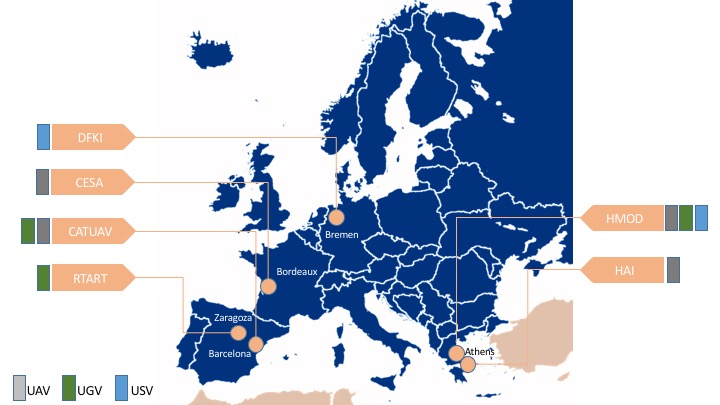RAWFIE searches for improvements in terms of new facilities (testbeds) that could host experiments and devices. First of all newcomers must specify:
- What type of testbed is, i.e. indoor or outdoor
- What type of devices it can host, i.e UAVs, USVs and UGVs
In the RAWFIE project testbeds can host more than one type of devices.
Requirements
The next step for the testbed providers is to ensure testbeds' compliance with the RAWFIE hard requirements in order to host devices and experiments. Each facility should provide closely monitored and controlled environments and should be able to:
- receive, inspect, assemble/fix and store UxVs
- provide emergency services (i.e., crash, fire or rescue) and recovery processes
- define minimum experimentation time
- have the appropriate equipment, both ground-based and mobile, to monitor and control vehicles, including
- Radar facilities or other kinds of equipment (e.g. cameras) for tracking and surveillance
- Telemetry facilities such as antennas, receivers, display instrumentation systems
- Command uplink and optical tracking facilities
- Premier digital photographic and video services including operation of still cameras, high speed and video systems for Range Safety support, surveillance, and post-launch analysis (e.g. failure analysis)
- a Person responsible in the field is needed with Visual Line of Sight (VLOS) during experiments' execution
- High bandwidth for supporting experiments with swarm of devices
- If a facility is dedicated to UAVs, then:
- The altitude must be more than 50 meters and below of 150m
- Must be away from populated areas
- Must provide remote pilot with VLOS, which shall be located at not more than 200m
- Must provide geofenced area with anti-collision systems
RAWFIE Technical Support
When the hard requirements listed before are fulfilled, and testbed facility joins the federation, then a contact point form the technical team of RAWFIE is assigned to the newcomers (testbed responsible/operators). Regular skype calls between the contact points and the new beneficiaries are established once-per-week for resolving questions and efficiently overview the testbed integration. RAWFIE team provides the testbed operators with a manual for using the web portal and a software package that contains all testbed software components (downloadable from the RAWFIE tickets and activities' tracking tool, based on Redmine, in the WP8 section). The Testbed Manager component provides a GUI for the configuration of the testbed and the insertion of the testbed vehicles (screenshots are given in deliverable D5.5, section 4.5.1). Testbed operators have access and control to the following aspects from the RAWFIE Portal:
- Define their preferable dates and times when experimenters can run experiments
- Accept/Reject a booked experiment in their testbeds
- Overview the experiments that will be conducted using their testbeds
- Visualize a running experiment and cancel if it necessary
All UxVs are operating in RAWFIE Virtual Private Network. RAWFIE provides all the necessary certificates in order to establish a VPN inside the infrastructure.
While the former idea within the project was to allow testbed owners to develop their own version of the testbed components (as it is currently written in the D4.8), subsequently the consortium decided that this will be forbidden, in order to increase compliance, safety and simplicity. Therefore testbeds' owners must use the software developed and provided by RAWFIE within their testbeds.
As long as the project is running, the contact point that will support testbeds representatives is the project coordinator UOA. Once the project is completed, the primary contact point will be established by the organisation that takes over the RAWFIE platform according to the federation policy established in Work Package 2 and deliverable D2.3 – Federation Policy.
Training
New testbed managers must participate in webinar organized by UoA about RAWFIE ethics requirements. Ethics requirements are detailed, and the strategies to mitigate the risk explained. The main focus of the webinar is the dual-use requirement, but the misuse requirements are also covered and instructions about how to deal with each of them are given.
Integrated testbeds
During the project lifecycle, six (6) testbeds were integrated in RAWFIE. These testbeds are operational and equipped with different types of devices.

Testbeds Distribution
